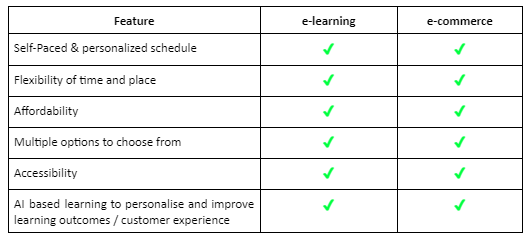What is e-learning?
e-learning (or, online learning) is the process of learning, conducted through electronic or online learning platforms. The use of the internet and gadgets like computers, tablets and smart boards form an essential part of it. e-learning can be divided into categories like Computer Managed Learning (CML), Computer Assisted Instruction (CAI), Interactive Online Learning and so on.
With the advancement of technology, e-learning complements the brick-and-mortar mode of teaching and learning; the former being deemed more democratic, flexible, portable, and productive than the latter. Over time, and especially post the Covid-19 pandemic, e-learning has made learning easily accessible for large sections of the student populace, who cannot avail it through conventional methods.
What is e-commerce?
e-commerce is the transaction of buying or selling products or services online. Some commonly used technologies that e-commerce uses include internet marketing, electronic funds transfer, online transactions and mobile commerce, among others. Hence, any form of business transaction which happens using an electronic mode is categorised as e-commerce.
Why is e-learning the next e-commerce?
It is expected that the trajectory charted by, and disruption brought forth by e-commerce will be closely emulated (and perhaps, surpassed) by the proliferation and easy accessibility of e-learning.
A number of factors, not least the tremendous social capital inherent to it, are going to contribute to the ubiquitousness of e-learning. Of course, the Covid-19 pandemic has only amplified the adoption and penetration of internet based learning. Between 2020 and 2024, the global online education market is expected to grow by ~USD 250 bn (at a CAGR of 18%). These effects can potentially affect generations of learners, across social and economic strata.
e-learning has democratised learning. A number of features, often not available in traditional brick-and-mortar classrooms, make online learning attractive. Legacy institutions like Harvard and Stanford are now jostling for a share of the e-learning pie alongwith upcoming ed-tech start-ups like Byju’s, Coursera and Unacademy.
Needless to say, the learning industry is currently undergoing a paradigm shift. Observers and industry experts argue that the world (and especially economies like USA, China and India) are now witnessing an offline to online to omni-channel migration in education. This path was treaded by the retail and commerce industry a few years back (brought forth by disruptors like Amazon and Uber (globally) and Flipkart (in India)).
One can, thus, list the features that appeal to the man on the street and observe that they are uncannily similar across both e-learning and e-commerce.

Challenges to e-learning:
e-learning has given way to multiple avenues of accessible learning. However, there are a few challenges that may inhibit the growth and penetration of this medium of instruction.
1. Comfort:
Students and learners in general are more comfortable studying in a classroom environment; a conducive and non-distracting option. E-learning may often leave the student lost, unless the teacher facilitates real-time group interactions.
2. Ease in teaching:
Audio-visual aids have revolutionized learning across generations. Teachers might find it difficult to adapt to a completely new approach, especially in countries with low exposure to internet. Also, a number of teachers are not digital-first citizens. Thus, their ability to be comfortable in leveraging online instruction remains a challenge.
3. Lack of clarity:
While e-learning offers a plethora of options when it comes to content, the overabundance of choices also has a negative side to it. Too much information often causes the infamous problem – “lost on the internet”, in students across age groups. Clear instructions on course work can aid learners with a concrete plan.
4. Boredom in students:
In a classroom setting, students derive a lot of motivation from their teachers and fellow learners. Despite its multiple advantages, online learning may often feel boring, cumbersome and lonely. Thus, the solution is for teachers to ensure that all students get the adequate amount of attention in each online class.
5. Reduced intellectual abilities:
e-learning can often hinder intellectual stimulation for students. Over dependency on technology is a reason for people not being able to logically organize their own thoughts or process information. To prevent students from losing their critical thinking and logical skills, it is important to have exercises like quizzes and multiple choice questions.
The above points give a glimpse into the challenges for the learner. There are also some industry level challenges to be noted. Often people working on designing online courses have to transform dull and unappealing subject matters to interesting programs which will appeal to different generations. Other challenges include finding qualified subject matter experts and instructors, while balancing tight roped budgets and unrealistic deadlines.
e-learning Platforms:
It is needless to say that IT and ITES can address most industry and student specific challenges. New-age digital tools, scalable platforms and tech-stacks, interventions like gamification and animation aimed specifically at millennials, and more ubiquitous and durable hardware products can synergise to ensure the uptick of e-learning. Simultaneously, there is a huge inflow of capital into education technology – as is evidenced by a 44% CAGR growth (2014-2020) to USD 16 bn. This alludes to the optimism around and the promise that this space holds.
Over and above the inherent challenges, externalities like internet penetration and government and legal policies and compliances will play a decisive role in the uptake of e-learning – as it has done in e-commerce. Conversely, newer technologies and innovations (like 3D tutorials, AI coaches, etc.) will fuel the demand for online learning.
In fact, today, these four important factors drive online learning:
- Employability – relevant education and skills for the upcoming job market.
- Skill Development – social and skill-based learning.
- Entrepreneurship – flexible learning opportunities for people in new businesses.
- Education – Over 1.2 billion students are out of school, post the pandemic. The learning for the students is happening digitally or remotely.
Industry experts expect these factors to remain relevant for decades to come. Consequently, the demand for online learning seems to be perennial. It is thus, an important moment in the timeline of education that we live in today. One where we are in a flux from a traditional way of living to a life dominated, and made simpler, by technology and innovation.
Final Thoughts:
Like other businesses, if you too are looking to develop IT Solutions in Edtech industry, Mindfire Solutions can be your partner of choice. We have gained significant experience over the years working with Edtech Companies. We have a team of highly skilled and certified software professionals, who have developed many custom solutions for our global clients over the years.
Here are a few interesting projects we have done in e-learning domain. Click here to know more:
Case study on Automated Education evaluation system.
Case study on auto tagging application for student collaboration and networking system.
